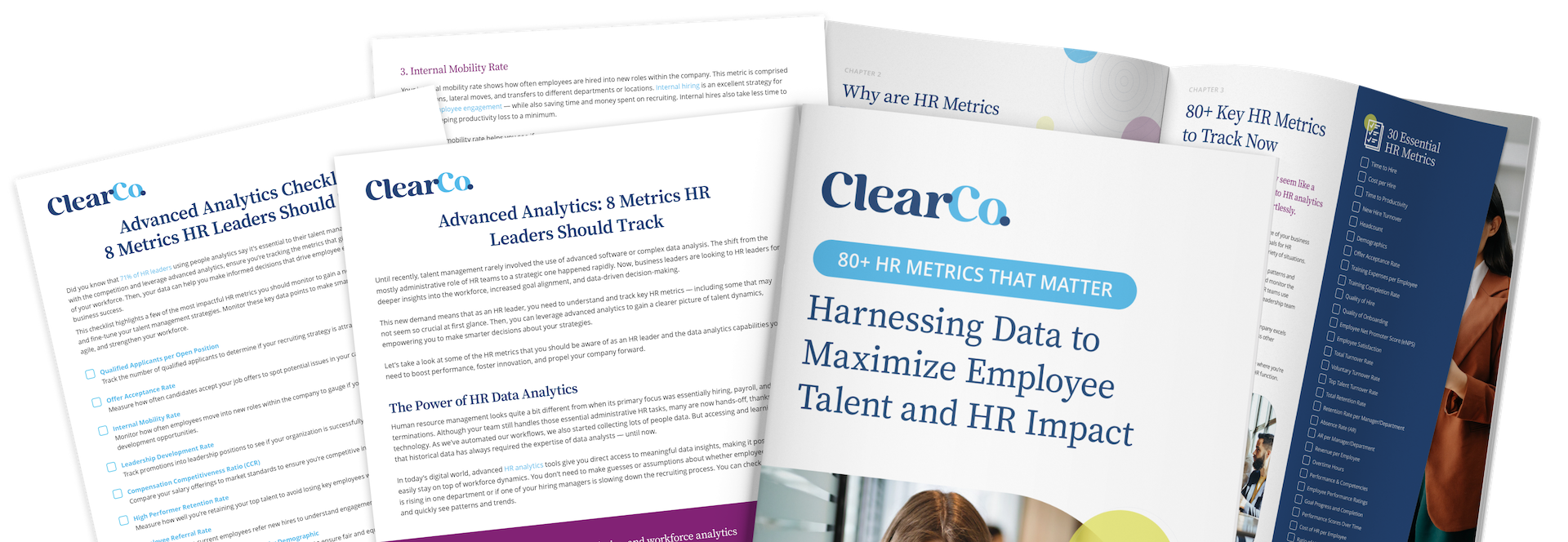Human resources has evolved quite a bit in the last several years. No longer is HR just about managing people. Today, HR teams are harnessing the power of their people data, with 78% of CHROs saying their organizations rely on talent data to make decisions.
A shift toward data-driven HR strategies allows you to make informed decisions that enhance talent acquisition, optimize workforce planning, and improve employee engagement. Leveraging data takes your team beyond guesswork with actionable insights, which help you create strategies that actually drive business results.
But what does it mean to be truly data-driven in HR? And how can you integrate data into the HR function and operate more efficiently and effectively?
Let’s dig into the concept of data-driven HR and its benefits. We’ll also share a few practical steps to help your team adopt a data-focused strategy with confidence and clarity.
What Is Data-Driven HR?
With a data-driven approach to HR, teams use their talent data to make decisions about HR strategy and policies, from recruiting to compensation planning to employee retention. The data collection and analytics capabilities of your human resources information system (HRIS) or other HR software help you identify patterns and uncover trends.
Arming your team with that knowledge enables you to make data-driven decisions and reach better outcomes. We say that data helps you make better decisions because it gives you insight into what’s actually happening in your organization. You’re not guessing or trying to remember what happened last year — you can consult the data and know for sure. Examples of those insights include:
- An increase in voluntary resignations in the finance department during Q2
- A trend of higher engagement among employees who participate in the mentorship program beyond their first year at the company
- Performance fluctuations that correlate with your industry’s busy seasons
- Unusually low engagement among new hires who were part of the same onboarding group
Timely insights like those tell you, for example, that you need to quickly find ways to engage those new hires and take steps to address any shortcomings in your onboarding process. With the advanced HR technology available today, you can find systems powered by artificial intelligence (AI) that serve up this information along with possible solutions.
The Benefits of Using a Data-Informed HR Strategy
Empowering your HR department with data and predictive analytics means you can take your strategy to the next level.
Take a look at a few of the top benefits of enabling HR teams with data.
1. Improved Decision-Making
We mentioned the fact that data-driven HR replaces guesswork with facts. You can rest assured that decisions are based on important HR metrics rather than intuition. For example, instead of relying on subjective assessments during hiring, your HR team can use data to identify the characteristics and skills that predict success for specific roles. Analytics tools can also help identify trends in turnover rates or assess the effectiveness of employee development programs.
You’ll no longer have to react to situations as they occur — instead, you can work proactively, getting ahead of potential issues and preventing catastrophes. That’s great for your people and for the organization.
2. Enhanced Employee Engagement
Engaged employees are pivotal to every company’s success. One of the benefits of using HR analytics software is the ability to measure those engagement levels regularly with surveys and real-time feedback tools.
With the responses you receive, your software can help you find factors that are contributing to disengagement, such as unclear communication or lack of growth opportunities. Then, you can put targeted solutions in place. For instance, flagging teams with lower engagement scores allows tailored interventions to fit each team’s needs.
3. Better Workforce Planning
You can’t make accurate plans for the future if you’re not digging into your data. From tracking your workforce demographics to forecasting future needs, data helps your HR team identify skill gaps, plan professional development, and align hiring strategies with projected business growth.
For example, predictive analytics can anticipate when specific roles may experience shortages. Your team can respond with proactive recruitment and upskilling to address shortages before they impact day-to-day operations.
4. Measurable Outcomes
One of the most significant benefits of data-driven HR is that it gives you the ability to measure outcomes. With data, you can quantify the effectiveness of HR strategies, whether that’s evaluating the ROI of training initiatives or the impact of onboarding on employee engagement.
That also boosts transparency and allows you to share those insights with leadership and the rest of the workforce. Sharing outcomes reinforces the value of HR and demonstrates accountability and progress toward your department’s goals.
5. Personalized Employee Experiences
With a data-driven strategy, you can provide employees with an unmatched level of personalization. For example, everyone has different working styles, preferences, and professional goals. Data enables you to design flexible work policies and development plans that fit those various needs.
Offering this level of customization fosters a more satisfied workforce, reducing churn and helping you attract and retain top talent.
6. Faster Responses to Challenges
Data-driven HR strategies give you a proactive edge by enabling your team to quickly identify issues. For instance, a rise in absenteeism might signal stress-related factors that require immediate attention. By using data to diagnose problems and track the success of interventions, your team can be agile and responsive, keeping disruptions to a minimum across the company.
Data-driven HR means not just aligning your team with business goals but also elevating its impact as a key driver of organizational success. When decisions are backed by real evidence, the HR function moves from a supportive role to a strategic partner and helps the entire organization thrive.
How to Become Data-Driven in HR
Becoming data-driven in HR doesn’t have to be overwhelming. Here are the key steps to get started:
- Invest in Analytics Tools: Use technology to track performance, analyze trends, and generate useful insights.
- Train Your Teams: Provide staff with the skills to interpret and use HR data effectively.
- Set Clear Goals: Define measurable objectives like improving retention or streamlining recruitment.
- Foster a Data-Driven Culture: Encourage decision-making based on evidence, supported by leadership commitment.
- Leverage Employee Feedback: Use surveys and sentiment tools to identify workforce needs and employee behavior patterns and act on them.
By taking these steps, HR teams can make informed decisions, align with company goals, and drive meaningful change.
Shift to a Data-Driven HR Strategy with ClearInsights
When it comes to the power of HR data and analytics software, there’s no system that can compare to ClearInsights by ClearCompany. ClearInsights equips HR teams with the tools and insights they need to adopt a data-driven approach seamlessly.
Here’s how ClearInsights transforms your HR strategy:
- Advanced Analytics: Identify trends, predict workforce needs, and uncover actionable insights to drive proactive decision-making.
- User-Friendly Dashboards: Simplify complex data with intuitive visual tools that make analysis accessible and actionable.
- Seamless Integration: Connect ClearInsights with your existing systems for streamlined data management and consistency.
- Actionable Recommendations: Go beyond reports with tailored suggestions to address challenges and boost results.
With ClearInsights, HR moves from reactive processes to strategic leadership. Empower your teams to drive measurable success with confidence.
The future of HR lies in the power of data. A data-driven approach goes beyond improving processes — it empowers HR teams to uncover opportunities, adapt strategies, and create a thriving workplace. It’s not just about shiny new software tools; it’s about reimagining how you use talent data to foster innovation, agility, and impactful leadership.
Start your transformation today. Download our Advanced Analytics Guide for actionable insights and solutions to elevate your HR strategy. Your smarter, data-informed future begins now.


.gif)
